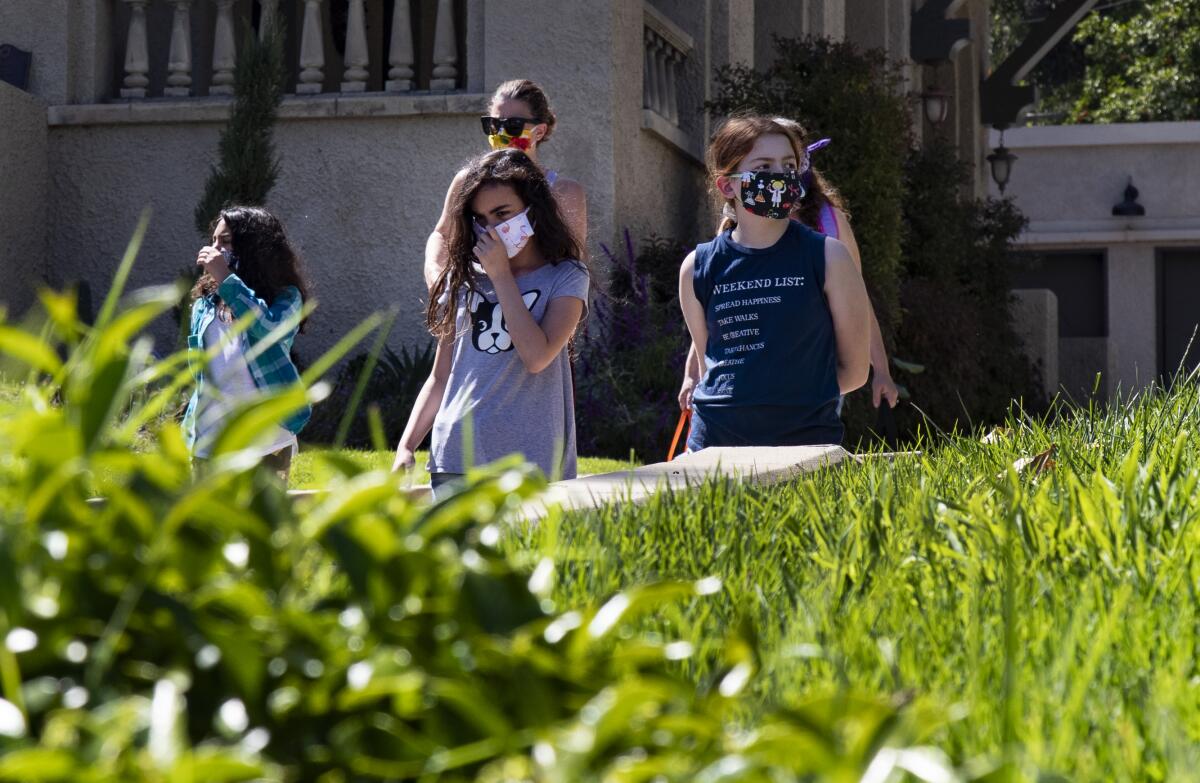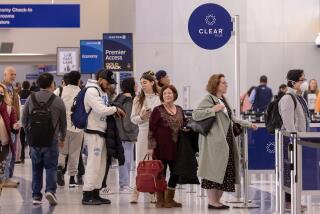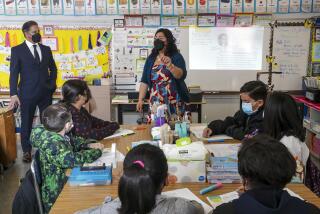Some California elementary schools could reopen if they meet state waiver rules

- Share via
Some California elementary schools may be able to reopen for in-person classes this fall under a strict waiver system announced Monday by state officials.
But because of the detailed rules, smaller schools — especially private and parochial campuses with more flexibility — will probably be among the most successful at meeting the special guidelines, prompting concern from some that select reopenings could add to gaps in educational equity.
Last month, Gov. Gavin Newsom announced that both public and private schools in California counties where the coronavirus continues to spread would be required to begin the fall with distance learning. Newsom’s guidance, which covers 38 of California’s most populous counties, means the majority of children in the state are unlikely to see the inside of a classroom until COVID-19 cases significantly decline.
But state health officials this week released criteria for local officials to use to evaluate if some schools can be exempted from Newsom’s order. Under the waivers, schools can petition their county health departments to allow hybrid online and in-person learning, or request full returns to classrooms. The waiver process is available only to elementary schools, whose young children have the most difficulty with online learning.
Dr. Erica S. Pan, California state epidemiologist and deputy director for the Center for Infectious Diseases, said available data suggest younger children are at lower risk of transmitting COVID-19 to other children and to adults.
She said the waivers are intended to “prioritize young children” and create flexibility for “certain parts of our state that are in a grayer area.”
The state guidance requires individual schools that want to reopen to submit plans that include rules for social distancing, protocols for how to handle outbreaks, a plan for testing if exposures do occur and criteria for when to close, among other information. District approval would be required for any school that seeks the waiver. The plans must be posted publicly.
Each school would have to come up with a plan specific to its circumstances, and the state guidance discourages waivers from being granted in counties where the infection rate is more than twice the threshold for being placed on the state monitoring list.
Because of the rules — such as a requirement to maintain six feet distance between students at all times — some education experts said the waiver is most likely to be granted in smaller public school districts and in private and parochial schools with fewer students. Public schools, most of which are already planning for remote education, would find it difficult to maintain the waiver standards, they said, and to pivot to attempting to qualify for a waiver quickly.
Deborah Dowling, executive director of the California Assn. of Independent Schools, which represents about 230 private schools in California, said she believes many private schools will request the waiver.
Prior to Newsom’s announcement of required distance learning, many parochial and independent schools around the state had already created plans for in-person learning and were taken by surprise when the governor included them in closures.
“I think what it really comes down to is, is the school nimble enough to find a way to meet the requirements, and being small makes you more nimble,” Dowling said. “If a school can safely reopen within the medical guidelines and minimize the danger to students and teachers and other employees, then it is very much in kids’ interest to learn in person.”
Lincoln Snyder, executive director and superintendent of schools for the Catholic diocese of Sacramento, said he understands concerns over equity, but many of the schools in his diocese include children from low-income households, and parents in the schools he oversees overwhelmingly are asking for in-person instruction. He has already begun working on waivers for 38 schools in seven counties. He is hopeful they will be granted soon.
“A number of the public health officers I have spoken with directly have a strong desire to see kids back in class,” Snyder said. “Our public health officers have been very open with us about wanting to work through this waiver process.”
Most private and parochial schools also have nonunion staff. Although the state guidance requires schools to confer with teachers and unions, if there is one, it does not require teacher or union consent to reopen under a waiver. Unions and their members have been vocal about safety concerns of returning before the virus is controlled.
Jeff Freitas, president of the California Federation of Teachers, said his organization opposes the waivers for that reason. The state’s two largest teacher unions — Los Angeles and San Diego — have just negotiated distance learning plans.
“If a county is on the monitoring list, there is a reason they are on the monitoring list, and without the testing and tracing the state needs to provide, it is not safe until these numbers come down,” Freitas said. “We feel that more privileged communities are going to be applying for those waivers, and it will create an additional inequality.”
For those schools that don’t qualify for waivers, the process of returning to campus is complicated.
Schools in the counties being monitored for coronavirus spread would not be able to reopen until they log at least 14 consecutive days of declining coronavirus cases and are removed from the watch list.
In counties with fewer coronavirus cases, the threshold for closing schools is dependent on outbreaks — classrooms where a student or teacher tests positive would need to quarantine at home. If multiple classes are infected, the school could be required to close. If more than a quarter of schools in a district have outbreaks, the entire district could be required to shut down.
Sacramento bureau chief John Myers contributed to this report.
More to Read
Sign up for Essential California
The most important California stories and recommendations in your inbox every morning.
You may occasionally receive promotional content from the Los Angeles Times.












